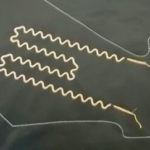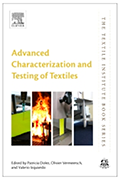
Evaluation of geomembrane UV exposure using geographic and climate data, by Beaumier, David, Eng. M.A.Sc., Fazli, Ali, Ph.D.
Presented during the ATA Geosynthetics, IGS session, February 8, 2023
Version disponible seulement en anglais.
ABSTRACT
Several geomembrane applications involve long-term UV exposure conditions: covers, ponds, leach pads, dams, and canals. High-density polyethylene (HDPE) geomembranes are used in most of these applications. In HDPE geomembranes, UV degradation (photodegradation) induced by long-term exposure to UV or visible light results in discoloration, surface cracks, brittleness, and deterioration in mechanical properties. This paper aims to present specific data from weather stations for the evaluation of light intensity with climates. Weather station data, including irradiance, UV index, latitude, longitude, and altitude, are used to calculate the effective irradiance on HDPE geomembranes. In addition, the orientation to sunlight changes the level of radiant energy on the exposed geomembranes. A model using radiant energy is proposed for guidance to service life prediction of exposed geomembranes.
Pour en savoir plus, cliquez ici.

Smart Textiles Testing: A Roadmap to Standardized Test Methods for Safety and Quality-Control (Octobre, 2021)
Chapitre du livre « Textiles for Functional Applications » qui a été rédigé par Ikra Iftekhar Shuvo, Justine Decaens, Dominic Lachapelle etPatricia I. Dolez.
Version disponible seulement en anglais.
ABSTRACT
Test methods for smart or electronic textiles (e-textiles) are critical to ensure product safety and industrial quality control. This paper starts with a review of three key aspects: (i) commercial e-textile products/technologies, (ii) safety and quality control issues observed or foreseen, and (iii) relevant standards published or in preparation worldwide. A total of twenty-two standards on smart textiles – by CEN TC 248/ WG 31, IEC TC 124, ASTM D13.50, and AATCC RA111 technical committees – were identified; they cover five categories of e-textile applications: electrical, thermal, mechanical, optical, and physical environment. Based on the number of e-textile products currently commercially available and issues in terms of safety, efficiency, and durability, there is a critical need for test methods for thermal applications, as well as to a lesser degree, for energy harvesting and chemical and biological applications. The results of this study can be used as a roadmap for the development of new standardized test methods for safety & quality control of smart textiles.
Pour en savoir plus, cliquez ici.

Antimicrobial Agents for Textiles: Types, Mechanisms and Analysis Standards (juillet,2021)
Chapitre du livre « Textiles for Functional Applications » qui a été rédigé par Ahmad Ibrahim, Joseph-Émile Laquerre, Patricia Forcier, Vincent Deregnaucourt, Justine Decaens et Olivier Vermeersch.
Version disponible seulement en anglais.
ABSTRACT
The large surface area, and ability to retain moisture of textile structures enable microorganisms’ growth, which causes a range of undesirable effects, not only
on the textile itself, but also on the user. Moreover, textiles used in health care environments are required to possess antimicrobial property to minimize spread of pathogenic infection. Anti-microbial property can be imparted via chemical finishing with an antimicrobial agent. Currently the use of antimicrobial agents includes metal compounds (notably copper and silver particle), chitosan, haloge-nated phenols “triclosan”, quaternary ammonium compounds, antibiotics (a class of antimicrobials produced from microorganisms that act against one another), and N-halamines. The possibility of bacterial resistance limits antibiotic use to specific medical applications, and triclosan is known for being dangerous to the environ-ment and is currently under scrutiny for possible endocrine disrupting to human being. Although quaternary ammonium compounds are stable and easily manufac-tured, microbial resistance is also a concern. Quaternary ammonium compounds (QACs), Polyhexamethylene Biguanide (PHMB), chitosan and N-halamines are listed under bound or non-leaching type antimicrobials. The bulk of current chapter focuses on the different family of antimicrobial agents used for textiles and their mechanisms.
Pour en savoir plus, cliquez ici.

Une innovation dans le domaine des couches isolantes
Article publié dans le magazine En Profondeur (Vol. 19, n° 4)
Qui, malgré la présence d’épaisses couches isolantes sous sa combinaison étanche, n’a jamais grelotté en fin de plongée?
L’élément «froid» est un incontournable de nos eaux québécoises. Grace a une innovation technologique, il devient possible d’accroitre son confort.
Pour en savoir plus, cliquez ici.

L’ouvrage Advanced Characterization and Testing of Textiles, coécrit par Patricia Dolez, Olivier Vermeersch et Valerio Izquierdo (Groupe CTT), offre un tour d’horizon complet des tests physiques et chimiques relatifs aux textiles. En présentant les grands principes de la caractérisation et des tests avancés, il plonge au cœur des méthodes d’essais spécifiques à chaque propriété textile et s’avère un outil précieux pour les gestionnaires en recherche et développement de l’industrie du textile, ou pour les étudiants ou chercheurs en sciences textiles.
Pour en savoir plus, cliquez ici.
Long-Term Performance of HDPE Geomembranes Exposed to High Service Temperature, une étude d’Andrew Mills et de David Beaumier (Groupe CTT) publiée dans la revue Geotechnical Frontiers 2017, se penche sur les performances d’une géomembrane résistante aux températures élevées évaluée pendant une période d’un an et comparée aux performances de géomembranes ordinaires.
Pour en savoir plus, cliquez ici.
Laboratory Measurement of the Linear Thermal Expansion of Geomembranes Using a Dynamic Mechanical Analyzer (DMA)
Si vous avez des questions à propos de cette conférence, veuillez nous contacter.
David Beaumier, Patricia Dolez, and Eric Blond, SAGEOS/CTT Group Thermal expansion is a critical property of geomembranes as it can affect the formation of wrinkles during their installation as well as for exposed applications. When an excessive number of wrinkles has developed because of an excessive dilatation of the geomembrane, these wrinkles may become interconnected, which increases the risk and extent of leakage. This paper introduces the test procedure that should be followed to permit the evaluation of thermal expansion characteristics of geomembranes using a Dynamic Mechanical Analyzer. It is shown that the test should be conducted with low applied stress and very low heating rate. In addition, the effect of the specimen width and length is analyzed. Finally, differences in behavior between machine and cross direction are characterized. Overall, it is concluded that this technique provides an effective tool for measuring the linear thermal expansion of geomembranes under conditions simulating their use in the field.
Stress-Cracking Resistance of a Bi-modal PE-RT HDPE Geomembrane
Si vous voulez en savoir plus, contactez-nous.
Rohit Sati, M.Sc, Layfield Group, 17720 – 129 Avenue NW, Edmonton, Alberta, Canada; e-mail: rsati@layfieldgroup.com
David Beaumier, Eng., M.Sc.A., CTT Group Sageos, 3000, avenue Boullé, St-Hyacinthe, Quebec, Canada; dbeaumier@gcttg.com
Abstract : Stress crack resistance (SCR) of high-density polyethylene (HDPE) geomembranes, with densities higher than 0.94 g/cc, has been widely researched and documented. Over the years, PE resin technology has evolved and has helped to improve many long-term performance properties including SCR. In this study, resistance to stress-cracking of bi-modal polyethylene raised temperature (PE-RT) HDPE was assessed and compared to HDPE and LLDPE geomembranes over a load range from 28 to 60% of yield stress. The higher tensile resistance of this specific bimodal resin resulted in higher resistance in the ductile failure mode than standard HDPE, but moreover, its stress-cracking resistance behavior was found without any clear transition of the failure envelope from a ductile to a brittle behavior. This observation suggests a longer projected lifespan of this unique bi-modal PE compared to existing geomembranes developed using unimodal resins. Previous studies on this material have analyzed tensile, antioxidant depletion, and resistance to brine and chlorine at elevated temperatures. In all cases, an improvement in durability was demonstrated. This study on stress cracking provides a comprehensive understanding of all known key mechanisms contributing to bi-modal PE geomembrane durability.
Présentée lors de la Geosynthetics Virtual Conference 2021 de l’Industrial Fabrics Association International (IFAI)
Analyse du potentiel d’application des textiles intelligents en santé et en sécurité au travail – rapport scientifique produit par le Groupe CTT en 2018 pour l’Institut de recherche Robert-Sauvé en santé et en sécurité du travail (IRSST)
Pour en savoir plus, cliquez ici.
Liens vers des ressources réglementaires :

